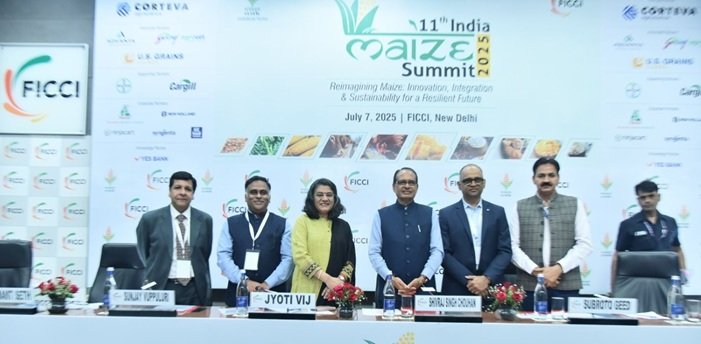Last Updated on July 7, 2025 7:24 am by BIZNAMA NEWS
Andalib Akhter / New Delhi
The 11th India Maize Summit, jointly organized by FICCI and the Indian Institute of Maize Research (IIMR), was inaugurated by the Union Minister of Agriculture and Farmers Welfare & Rural Development, Shivraj Singh Chouhan.
In his keynote address, Mr Chouhan reiterated the government’s commitment to farmer welfare, calling it the “mool mantra” of their policies. He outlined a comprehensive strategy to enhance maize production, raise farmer incomes, and ensure environmental sustainability. Emphasizing the importance of research, farmer education, and modern agricultural practices, he shared the government’s ambitious vision to transform India’s maize sector. He emphasized that state and central government scientists, farmers, agricultural universities, and industry must work together to fulfil this goal.
India’s maize production has surged from 10 million tonnes in the 1990s to over 42 million tonnes today, with a target of 86 million tonnes by 2047. Despite this growth, productivity remains below global standards at 3.7 tonnes per hectare, with states like Bihar and West Bengal leading in yields.
Under the ‘Viksit Krishi Sankalp Abhiyan’ campaign, around 11,000 scientists and officials were deployed to nearly 8,000 villages to bridge research and field application gaps. “Scientists will go to farmers’ fields,” the minister said.
Uttar Pradesh’s Agriculture Minister, Surya Pratap Shahi, highlighted the state’s rapid maize expansion under the Accelerated Maize Development Program. The program, spanning 24 districts, now covers 540,000 hectares, with yields reaching 34 quintals per hectare and projected to exceed 40 this season. UP has also attracted around 15 maize-processing companies and is exploring value-added products like biodegradable fibre alternatives to plastic. The government supports farmers through minimum support price schemes and improved seed availability.
FICCI’s Subroto Geed called maize a “national imperative,” stressing the need to boost productivity via advanced technology, resilient seed systems, and digital tools. He advocated a collaborative ecosystem among farmers, government, industry, and researchers to build a climate-smart, competitive maize economy.
Dr. H.S. Jat of IIMR outlined targets to grow maize production by 8-9% annually, aiming for 65-70 million tonnes by 2030 to support India’s ethanol blending goals. He highlighted the need to improve starch content in hybrids to increase ethanol yield from maize and detailed efforts to develop high-yielding, high-fermentable varieties suited for different cropping seasons.
YES BANK’s Sunjay Vuppuluri presented market data showing maize as India’s fastest-growing cereal crop, with a 31% increase in acreage and 75% rise in production over the last decade. However, he noted a looming demand-supply gap, with consumption growing faster than production. Poultry feed and ethanol remain the primary drivers of demand, underscoring maize’s strategic role in food and energy security.
The minister also honored progressive farmers for their outstanding contributions to maize cultivation, recognizing their pivotal role in the sector’s growth.



